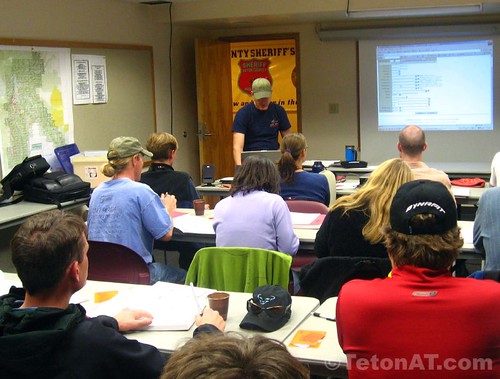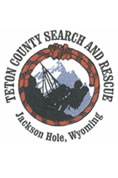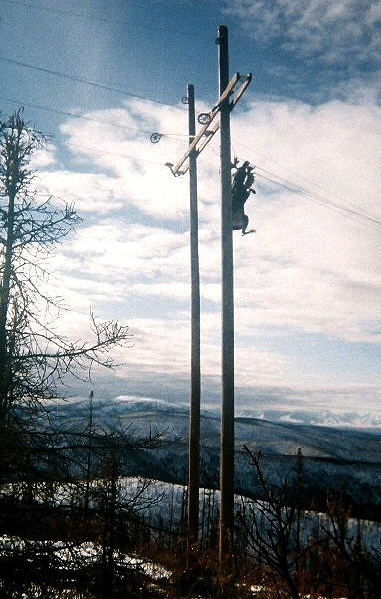
The TCSAR crew getting in some classrooom time at the Sheriff’s Office.
As a volunteer member of Teton County Search and Rescue, one of the new tools and techniques I am training for is for the ability to do a short-haul from a helicopter. This is basically when your are suspended beneath the helicopter with a 100′ cable and flown a short distance to a specific location. We are just finishing up with the classroom side of things and will get going training with the heli soon.
 Now…dangling yourself below a helicopter may sound kind of dangerous, but the truth is that it can often be a lot safer than the alternative of rappeling. While rappelling from a helicopter to access hard to reach locations does have it merits for long distance insertions, short hauling is much safer because it reduces some of the hazards relating to the human element and getting tangled with the rope in windy sometime associated with rappelling. Obviously the ability to drop someone off at a location that may be too small to land in is an obvious benefit of the short-haul. Toe in landings can be dangerous to say the least and many of the auto-rotate hazards (when the helicopter instantaneously rolls over when close to the ground) can be greatly reduced by getting up off the deck a bit. Helicopters like balance, and centering the weight directly bellow the rotor-blades make the load more controllable and predictable. This will often allow the helicopter to carry more weight as well…hopefully that means my skis!
Now…dangling yourself below a helicopter may sound kind of dangerous, but the truth is that it can often be a lot safer than the alternative of rappeling. While rappelling from a helicopter to access hard to reach locations does have it merits for long distance insertions, short hauling is much safer because it reduces some of the hazards relating to the human element and getting tangled with the rope in windy sometime associated with rappelling. Obviously the ability to drop someone off at a location that may be too small to land in is an obvious benefit of the short-haul. Toe in landings can be dangerous to say the least and many of the auto-rotate hazards (when the helicopter instantaneously rolls over when close to the ground) can be greatly reduced by getting up off the deck a bit. Helicopters like balance, and centering the weight directly bellow the rotor-blades make the load more controllable and predictable. This will often allow the helicopter to carry more weight as well…hopefully that means my skis!
Anyway, things should start to get a bit more interesting with the trainings when we start working with the ship and I’m getting kind of excited. Maybe I can wear the helmet cam on some flights!

The short-haul might help in this rescue!

Steve how in the hell did that happen to the moose in the picture do tell?
Here’s the story on the moose from the Anchorage Daily News:
http://www.adn.com/news/alaska/wildlife/moose/story/8806815p-5613350c.html
Basically, the moose got entangled in the power line while it was being installed. The crew farther up the line tightened it and raised the moose 50 feet into the air.
Steve-
As always, great blog.
As for helo ops, here are a few points:
As you point out, hanging below a helo is NEVER safe. Even the military limits rappels and fast roping to specially trained personnel and crew, and besides what recruiting commercials would have you believe, its only used as a last resort.
It would be interesting to hear more about your training as I wonder what it takes for a SAR coordinator to decide that the risk is worth the reward. Too many times, I have seen perfectly good SAR resources used up when the mission was obviously out of reach. The participants are “go getters” and sometimes this pushes them to not properly asses the risk and, unfortunately, make the hard decisions to say no to a scenario. No one wants to say “no” to a mission, no one wants to leave “someone” out there. But, often times, the cold, hard numbers don’t add up.
I just cannot think of many times that suspending a person below a cable on a helo is a good idea. The risk is great, much greater than a hollywood movie would lead one to believe. Wind, weather, helo capability, pilot training, pilot fatigue, SAR personnel training, SAR personnel fatigue levels ….. the list goes on and on. I urge all of you participating in SAR and helo ops to accurately asses the dangers involved.
Just a few random thoughts from a former helo pilot with many hours in the mountains ….
PS – Technically speaking, auto rotation is what happens when a helo loses engine power and must use gravity and “induced flow” to the rotor blades to maintain rotor RPM in preperation for cushioning a crash landing. Guess where that person hanging from the cable is going to end up in that scenario? Not pretty bro.
The situation where an aircraft “instantaneously rolls over” when close to the ground is called “dynamic roll over.” It only happens as a result of poor pilot training and/or poor pilot atttentiveness. Proper LZ choice can minimize this, but ultimately, its up to the pilot to know his machine and his/her capabilities.
Hate to be a downer, but just like avy training, real life isn’t a TGR movie.
DG
Thanks for your commments Derik! It’s always great to have experts chime in.
I think the biggest reason for us to use short-haul is because of the lack of sufficient LZ’s near may of our rescues. Last winter, there were two occasions, the Darby and Claw incidents, where the LZ’z were not optimal and maybe some excess risk was taken by landing in them. Theoretically short hauling would have minimized this risk.
Time will only tell how often we will use short-haul as a tool and for now, only some of us on the team are getting trained for it.
Steve-
I wish I knew all there was to know. I am sure the Teteon county guys are safe and concientious. Take care and be safe.
D